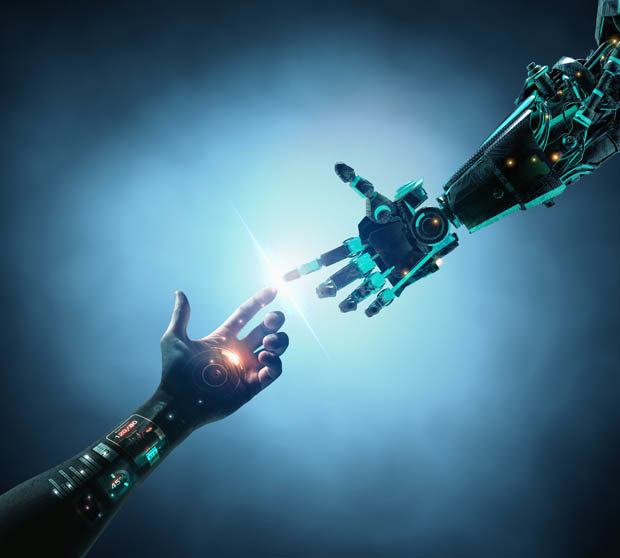HUMANS and robots can make babies together using genetic engineering to create a new hybrid species from skin cells, a leading AI expert will announce in a groundbreaking speech.

Dr David Levy, a world leading artificial intelligence researcher, will explain how the genetic information of cells can be manipulated to create a baby with human and robot DNA in his key note speech at the Third International Congress on Love and Sex with Robots.
Speaking at the conference in London on Wednesday, December 20, Dr Levy will explain how advancements in cell biology and bio robotics have led to his extraordinary conclusion.
Ahead of his speech, Daily Star Online can exclusively reveal extracts of his radical research paper, titled “Can Robots and Babies Make Humans Together?”
In his conclusions, Dr Levy, author of Love and Sex with Robots, will argue that “it is possible” for humans and robots to make babies given “recent progress in stem cell research and artificial chromosomes”.
His speech will draw heavily on research in the fields of stem cells, bio nanotechnology and robot genetics.
Researchers at the Ohio State University Wexner Medical Center have developed a nanotechnology-based chip that can successfully inject genetic code into skin cells, Dr Levy will say.
In the future, scientists will be able to use this chip process, called “tissue nano transfection” (TNT), to allow “the genetic code of a robot to be passed on to its offspring along with human genetic code”, he will say.
This genetic code can be injected into skin cells that are capable of being turned into embryos and sperm – rendering sexual intercourse and IVF redundant, he will say.
“Suddenly the very real possibility has appeared on the horizon of the robots of the future manipulating human skin cells to create human sperm and human eggs, and from them, using the Ohio discovery of TNT as the basis, creating an entire human baby whose embryo can be nurtured and carried through pregnancy by a mother surrogate,” he will conclude.
“This is how I believe it will be possible, within the foreseeable future, for humans and robots to make babies together.”
In his final remarks, Dr Levy will ask: “Will this happen in my lifetime?”
His theory is that “given the phenomenal rate of discovery and progress in the fields of cell biology and nanotechnology”, the prospect of human-robot hybrid babies “is an odds-on cert” within the next 100 years.
Dr Levy will say these advancements would not be possible without the biological breakthroughs of scientists throughout the past century.
Since the dawn of humanity, Dr Levy will say, sexual intercourse between a man and a woman was universally accepted as the only method by which a child could be conceived and born.
But that changed in July 25th, 1979, when Louise Brown, the world’s first “test tube baby”, was born after conception by in vitro fertilisation, commonly known as IVF.
“With the advent of IVF, science rewrote the conception rule book and provided the impetus for researchers to investigate possible alternative means of human reproduction,” Dr Levy, an international chess master, will say.

Equally important was the research of British embryologist John Gurdon, whose experiments on frogs proved the make-up of stem cells could be altered, overturning a “a fundamental belief in biology”.
Stem cells, found in embryos, are a special type of cell that can grow into any type of cell found in the body.
Until Gurdon’s experiments 1962, it was believed stem cells lost the ability to change into other cells once they had “specialized”.
But Gurdon proved that “every cell in the body still contained all that genetic information” – a major breakthrough that allowed him to “clone” a frog and subsequently a sheep, famously named Dolly.
Japanese researcher Shinya Yamanaka, co-winner of the 2012 Nobel Prize, made further advancements in stem cell research by reprogramming mature cells into immature cells.
In April 2016, Stanford University and the Valencia Infertility Institute announced a project in which human sperm, with tails, were created from skin cells.
In September 2016, researchers led by Tony Perry at the University of Bath reported that they had discovered a method of creating offspring without the need for a female egg.
This research allowed Dr Levy to conclude that a baby can be conceived without IVF treatment or sexual intercourse.
In terms of robot genetics, Dr Levy will cite the research of a South Korean team lead by Jong-Hwan Kim, a pioneer in the fields of Ubiquitous Robotics.
Kim and his team created the world’s first robotic chromosomes – a set of computerized DNA codes for creating artificial creatures that can have their own personality.
This virtual DNA could be injected into skin cells through TNT, thereby passing on its genetics to offspring, he will say.
Dr David Levy is speaking at the Third International Conress on Love and Sex with Robots on December 20, 2017.